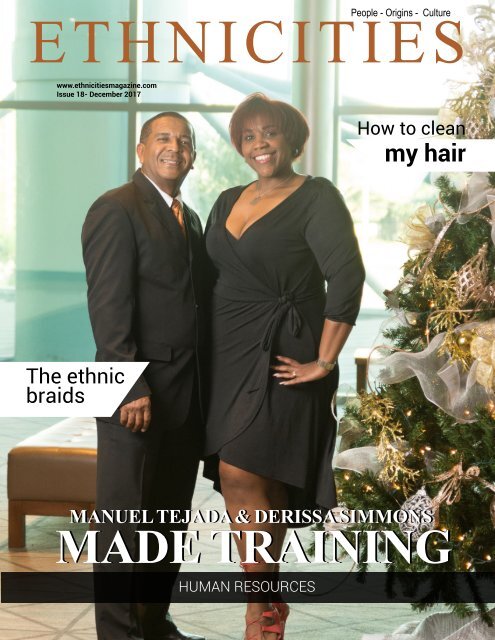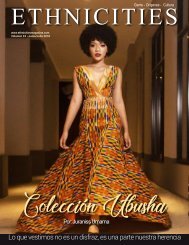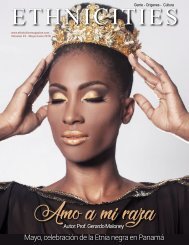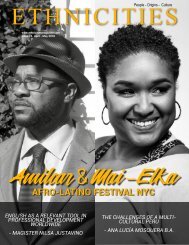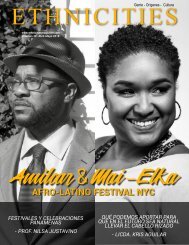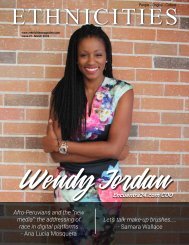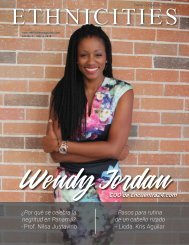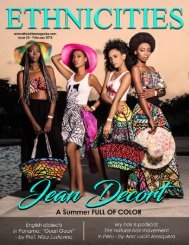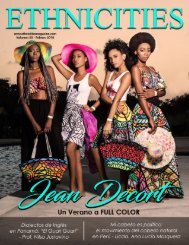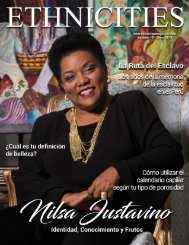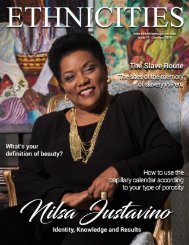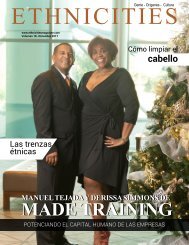Ethnicities Magazine_December 2017_Issue_18
You also want an ePaper? Increase the reach of your titles
YUMPU automatically turns print PDFs into web optimized ePapers that Google loves.
People - Origins - Culture<br />
ETHNICITIES<br />
www.ethnicitiesmagazine.com<br />
<strong>Issue</strong> <strong>18</strong>- <strong>December</strong> <strong>2017</strong><br />
How to clean<br />
my hair<br />
The ethnic<br />
braids<br />
MANUEL TEJADA & DERISSA SIMMONS<br />
MADE TRAINING<br />
HUMAN RESOURCES
CONTENT<br />
ETHNICITIES<br />
Carta Editorial<br />
Licda. Keila Salazar de Moreno<br />
The ethnic braids and their western cultural trascendence................3<br />
Magister, Nilsa Justavino<br />
Becoming an Entrepreneur: From a dream to reality.............................8<br />
Derissa Simmons, B.A.<br />
How to clean my hair correctly...................................................................12<br />
Kris Aguilar, B.A.<br />
The Afro-Peruvian movement: origins, development and future<br />
challenges...........................................................................................................14<br />
Ana Lucía Mosquera, B.A.<br />
Wafrica: The third aesthetic..........................................................................17<br />
Ninna Ottey, B.A.<br />
3<br />
THE ETHNIC BRAIDS AND<br />
THEIR WESTERN CULTURAL<br />
TRASCENDENCE<br />
Holiday Glam Guide........................................................................................25<br />
Samara Wallace, B.A.<br />
Made Training – Interview............................................................................28<br />
<strong>Ethnicities</strong> <strong>Magazine</strong><br />
Los ángeles de la guarda..............................................................................34<br />
Licda. Jessica Bernard<br />
Socials..................................................................................................................37<br />
12<br />
HOW TO CLEAN MY HAIR<br />
CORRECTLY<br />
1<br />
**<strong>Ethnicities</strong> <strong>Magazine</strong> investigates the seriousness of their advertisers,<br />
but i not responsible with related offers they do. The<br />
opinions expressed by the authors do not necessarily reflect the<br />
position of editor of the publication, total or partial reproduction<br />
of the content and images of the publication without prior authorization<br />
of <strong>Ethnicities</strong> <strong>Magazine</strong> is strictly prohibited.<br />
28<br />
MADE TRAINING<br />
-INTERVIEW
FOUNDER & EDITOR IN CHIEF<br />
Keila Salazar de Moreno, B.A.<br />
info@ethnicitiesmagazine.com<br />
EDITORIAL LETTER<br />
ASSOCIATE EDITOR AND COLLABORATOR<br />
Judith Rapley, M.S.W.<br />
judith@judithrapley.com<br />
GRAPHIC DESIGN<br />
Stephany Salazar, B.A.<br />
stephany.salazar20@gmail.com<br />
PHOTOGRAPHS<br />
www.pixbay.com<br />
Andres Salazar, B.A.<br />
COVER AND INTERVIEW CONTENT<br />
PHOTOGRAPHS<br />
Andres Salazar, B.A.<br />
DECEMBER WRITES<br />
Magister, Nilsa Justavino<br />
Ana Lucía Mosquera, B.A.<br />
Kris Aguilar, B.A.<br />
Samara Catherine Wallace N., B.A.<br />
Jessica Bernard, B.A.<br />
Derissa Simmons, B.A.<br />
Ninna Ottey, B.A.<br />
Keila Salazar de Moreno, B.A.<br />
SALES, MARKETING AND PUBLIC<br />
RELATIONS<br />
Keila Salazar de Moreno, B.A.<br />
SPANISH VERSION CORRECTION<br />
Keila Salazar de Moreno, B.A.<br />
Stephany Salazar, B.A.<br />
ENGLISH VERSION CORRECTION<br />
Judith Rapley, M.S.W.<br />
This month of <strong>December</strong>, I just want to express my deepest gratitude<br />
for your unconditional support during this year <strong>2017</strong>, and we will come<br />
with much more for 20<strong>18</strong>.<br />
Thanks to all our columnists: Marvin Martinez, Ana Lucia Mosquera,<br />
Jessica Bernard, Samara Wallace, Ninna Ottey, Professor Nilsa Justavino,<br />
Kris Aguilar, Dr. Daphney Visuette and many others who have<br />
collaborated with us throughout the year, without you <strong>Ethnicities</strong> <strong>Magazine</strong><br />
would not be so rich in content, you are wonderful; thanks to<br />
all those who allowed us to interview them to be part of our content<br />
throughout the year: Urenna Best, Dr. Vania Barrow, Dr. Aris Latham,<br />
Natalie Harris, Said Isaac, Abel Aronategui, Miroslava and Tatiana of<br />
Afrodisiaca and in our <strong>December</strong> edition Derissa and Manuel of Made<br />
Training; and finally, to those who make all the magic of the covers and<br />
the visual content of the interviews and other sections a reality, to all<br />
the photographers who supported us during this <strong>2017</strong> with their wonderful<br />
talent: Stephany Salazar, who is also our graphic designer; Vina<br />
Yetman with the covers and fashion trends since June of this year;<br />
Andrés Salazar who was in charge of the cover and interview photos<br />
for this <strong>December</strong> issue and our friend Ireul from Colón, who took the<br />
pictures of our October issue.<br />
We wish you success for this new year that is coming, and we hope to<br />
continue counting on you in each of our facets.<br />
WEBMASTER<br />
Keila Salazar de Moreno, B.A.<br />
www.ethnicitiesmagazine.com<br />
Keila Salazar de Moreno<br />
Presidenta y Editora en Jefe<br />
<strong>Ethnicities</strong> <strong>Magazine</strong><br />
CONTACT<br />
+507 62523175<br />
2
ETHNICITIES<br />
AFRO PANAMEÑOS<br />
THE ETHNIC BRAIDS AND THEIR WESTERN<br />
CULTURAL TRANSCENDENCE<br />
BY: MAGISTER, NILSA JUSTAVINO DE LOPEZ<br />
Today we celebrate ethnic braids, which<br />
have their roots in the oldest customs of<br />
blackness. Related to this topic, Okot P. Bitek,<br />
a Ugandan poet, in his “Canto De Lawino”,<br />
says:<br />
3
THE BEAUTIFUL GIRAFFE CAN-<br />
NOT BECOME A MONKEY<br />
My mother taught me<br />
Acoli hair fashions;<br />
Which fits the kind<br />
Of hair of the Acoli,<br />
And the occasion.<br />
Listen,<br />
Ostrich plumes differ<br />
From chicken feathers,<br />
A monkey’s tail<br />
Is different from that of a giraffe,<br />
The crocodile’s skin<br />
Is not like the guinea fowl’s,<br />
And the hippo is naked, and<br />
hairless.<br />
No leopard<br />
Would change into a hyena,<br />
And the crested crane<br />
Would hate to be changed<br />
Into the bold-head<br />
Dung-eating vulture,<br />
The long-necked and graceful<br />
giraffe<br />
Cannot become a monkey.<br />
Let no one<br />
Uproot the pumpkin.<br />
The hair of the Acoli<br />
Is different from that of the<br />
Arabs;<br />
The Indian’s hair<br />
Resembles the tail of the horse;<br />
It is like sisal strings<br />
And needs to be cut<br />
With scissors.<br />
It is black,<br />
And is different from that of<br />
white women.<br />
I am proud of the hair<br />
With which I was born<br />
And as no white woman<br />
Wishes to do her hair<br />
Like mine,<br />
Because she is proud<br />
Of the hair with which she was<br />
born,<br />
And arranges the edges<br />
With much care<br />
So that it covers<br />
Her ears<br />
As well as the bold forehead<br />
That jumps sparks<br />
When lightning has splashed,<br />
And hurls back sunlight<br />
More powerfully than a mirror!<br />
4
AFRO PANAMEÑOS<br />
ETHNICITIES<br />
The African woman spreads<br />
an extraordinary fantasy in her<br />
personal headdress; African<br />
hairstyles are incomparable in<br />
elegance and beauty, superior<br />
to any place in the world. They<br />
constitute an aesthetic conception,<br />
they are as varied as original,<br />
true craft creations, which<br />
require time, patience and good<br />
taste.<br />
The filigrees of tiny braids resemble<br />
crochet embroidery.<br />
The hair of the black race, extraordinarily<br />
curly and small,<br />
allows you to add objects, such<br />
as beads or ribbons that enhance<br />
its structure, especially natural<br />
substances that stretch and<br />
dye in the most varied ways you<br />
can imagine. The elaboration<br />
of these hairstyles is slow and<br />
meticulous, but the final result<br />
is a piece of art.<br />
Row braids are a widespread<br />
custom throughout the African<br />
continent, and are characterized<br />
by their age. The Nok civilization<br />
of Nigeria shows these elaborate<br />
headdresses and dates<br />
back to 500 years before Christ,<br />
as witnessed in “hieroglyphics<br />
and sculptures of thousands<br />
of years, attesting to the special<br />
attention that Africans dedicated<br />
to their hair. The braids<br />
also appear on the back of the<br />
head of the majestic (Egyptian)<br />
sphinx. (Peters, 1990).<br />
Braid headdresses in Africa<br />
encompass a broad cultural<br />
spectrum: they represent religious<br />
rites, family relationships,<br />
status, age, ethnicity and other<br />
attributes of identity that can be<br />
expressed in the style in which<br />
the hair is braided. In the same<br />
way, the ritual of braiding the<br />
hair is significant, which transmits<br />
cultural values from generation<br />
to generation, expressing<br />
the bonds between friends and<br />
establishing the role of the professional<br />
practitioner.<br />
There is a great variety of traditional<br />
African styles that go<br />
from the most complex and<br />
spiral curves to the strictly linear<br />
composition of the Ivory<br />
Coast. The geometric patterns<br />
in braiding are traditional in<br />
African culture. Mathematics<br />
in the elaboration of braiding<br />
style are part of the tradition.<br />
Like many other “Africanisms”<br />
brought to the new world, African<br />
headdresses transcended<br />
the intermediate transfer of slave<br />
transport. The blacks, once<br />
captured, shaved their heads,<br />
ostensibly for health reasons;<br />
However, this left psychological<br />
traces among others, being<br />
stripped of their culture. When<br />
restoring the styles of hairstyle<br />
traditions in the New World was<br />
an act of covert resistance, a<br />
fact that could go unnoticed,<br />
for example, the pañolones and<br />
turbans worn on the head. (Rebecca<br />
Busselle, 1970)<br />
Braided hair transcends the<br />
intermediate passage of slave<br />
traffic. “The slaves who worked<br />
inside the big houses on<br />
the plantation were required to<br />
present themselves impeccable<br />
... so men and women often<br />
wore well-interlaced braids,<br />
bunches and braids in a row<br />
(made by sectioning the hair<br />
and a flat braided, well adjusted<br />
to the leather hair).These patterns<br />
were based on traditions<br />
brought from Africa. Later, other<br />
styles were developed from an<br />
amalgam of traditional African<br />
styles, European trends and<br />
even some inclusions of the<br />
braid of the Native Americans<br />
(Byrd and Tharpes, 2001). In the<br />
notices of where the images of<br />
the fleeing slaves appeared, the<br />
variety of styles used shows<br />
greater extravagance, in open<br />
rebellion and defiance against<br />
the oppressive target. Free Africans<br />
in the north of the United<br />
States groomed themselves<br />
with a great variety of styles ...<br />
(White and White, 1998).<br />
The concept of hair stretching<br />
has its beginnings after the<br />
civil war in the United States.<br />
Madame C. J. Walker invents<br />
a hair stretching system that<br />
prevents damage caused by<br />
other methods. Until then, the<br />
braids had played a very special<br />
place in the cultural syncretism<br />
of black in the colony. The<br />
notion of “good hair” and “bad<br />
hair” had given rise to the hot<br />
comb, introduced to the western<br />
world by the French on the<br />
Caribbean islands and Louisia-<br />
5
na. The hot comb is established<br />
as a fundamental element of the<br />
black beauty industry that has its<br />
beginnings in the first decades<br />
of the 20th century. Hot combs<br />
surpass the oldest methods<br />
used by slaves, which vary between<br />
knives heated to charcoal,<br />
fat for shafts and potash made<br />
at home. The hot comb, an iron<br />
comb heated to the charcoal of<br />
the coal, generated a temperature<br />
between 300 and 500 degrees<br />
Fahrenheit. Upon contact with<br />
the hair prepared with bergamot,<br />
coconut, and other homemade<br />
preparations, the strand of hair<br />
lost its frizzy consistency and<br />
as the temperature cooled, it remained<br />
straightened. Some consequences<br />
of this method were<br />
burns or lacerations due to iron<br />
contact and the consequent alopecia<br />
or hair loss very common<br />
in black women of the Caribbean<br />
exposed to this method.<br />
Black soap is another tradition<br />
from southern and western Africa.<br />
It was used to wash hair. Originally<br />
from Togo, Black Soap<br />
is also known as African Black<br />
Soap or “Beldi” Soap. Excellent<br />
cleaner that is still traditionally<br />
made by hand in Africa, mainly<br />
in Morocco. It also contains coconut<br />
oil, purple corn and palm<br />
kernel oil, nut oil that was used<br />
to lubricate the scalp. In northern<br />
Africa, argan oil was used to protect<br />
the scalp from the sun and<br />
the arid climate. Fixing hair was<br />
an intimate, spiritual aspect of<br />
personal well-being, and sometimes,<br />
it was a process of many<br />
days to achieve the hair and the<br />
skill to achieve it.<br />
Although the adults stretched<br />
their hair, the tradition of the<br />
braid continued in the children’s<br />
hair. “At the knees of the grandmothers,<br />
the girls wore their first<br />
bunches or braids woven in a hair<br />
cared for by brushing, lubrication<br />
that encouraged their growth.<br />
Despite the growing trend of hair<br />
straightening at the beginning<br />
of the 20th century, school girls<br />
wore braided hair and adorned<br />
with headbands, hooks, colored<br />
ribbons or hairpins. Only on Sundays<br />
or special dates, they could<br />
wear loose or curly hair with hot<br />
combs, this style requires daily<br />
care and is not suitable for the<br />
activities and schedules of children<br />
and their working mothers.<br />
(Peters, 1990).<br />
In the 1950s, as a result of the<br />
African revolts against colonialism<br />
and apartheid and the beginning<br />
of the political-cultural<br />
movement of civil rights, African-American<br />
artists, intellectuals<br />
and activists began to use<br />
African styles. Persistent row<br />
braid styles in places like North<br />
Carolina give rise to a rediscovery<br />
of the traditions that survive<br />
from slavery (Biggers, 1999, Jackson,<br />
2000). To emphasize even<br />
more in the trend, they decide to<br />
make fashionable the “ruffled”<br />
hair and others the braids and it<br />
is called “afro” style. Singers like Odetta,<br />
Miriam Makeba, Nina Simone, activists<br />
like Angela Davis appear in 1969 wearing<br />
braids as part of their solidarity with<br />
the Black Power. Later, some opt for the<br />
most complicated braiding techniques,<br />
and in the 70s, when hip-hop emerged<br />
as a predominantly black cultural movement,<br />
the “philadelphia” cut and the<br />
braids are established as the styles of<br />
the Afro-Futurist movement that gives<br />
rise to the geometric emphasis on black<br />
hairstyles.<br />
6
AFRO PANAMANIANS<br />
ETHNICITIES<br />
REFERENCES:<br />
AFRICA BEFORE SLAVERS.<br />
WWW.AWESOMESTORIES.COM<br />
AYANA BYRD AND LORI THARPES.<br />
HAIR STORY: UNTANGLING THE<br />
ROOT OF BLACK HAIR IN AMERICA,<br />
2001.<br />
TERRI DANIEL. AFRICAN AMERICAN<br />
HAIR. THE HISTORY OF THE HOT<br />
COMB.<br />
JAMES A. THOMAS, MD. DETROIT MI-<br />
CHIGAN RACE, COLOR, AND ESSEN-<br />
TIAL HYPERTENSION: A PROPOSAL<br />
FOR AN INTERNATIONAL SYMPO-<br />
SIUM.<br />
SHANE WHITE, GRAHAMA WHITE.<br />
STYLING: AFRICAN AMERICAN EX-<br />
PRESSIVE CULTURE FROM ITS BE-<br />
GINNINGS TO THE ZOOT SUIT. 1992<br />
THE ILLOGICAL PSYCHOLOGY OF<br />
BLACK HAIR TEXTURES. BY SHERYL<br />
ESTRADA / FEBRUARY 13, <strong>2017</strong><br />
TRIBUS DE AFRICA. CBTIS229.BLOGS-<br />
POT.COM<br />
WIKIPEDIA. AFRICAN AMERICAN CUL-<br />
TURE<br />
07
BECOMING AN<br />
ENTREPRENEUR:<br />
FROM A DREAM<br />
TO A REALITY<br />
BY: DERISSA SIMMONS<br />
DIRECTORIA ACADÉMICA - MADE TRAINING SOLUTIONS<br />
info@madetrainings.com<br />
Being an entrepreneur has become<br />
very common in our society<br />
today, and it all began in the mid-<br />
80`s because there was a change<br />
with the emergence of companies<br />
such as Microsoft, Apple,<br />
Oracle and Adobe. And during<br />
that time, the entrepreneurs went<br />
from social misfits that could not<br />
find a job to more accepted people.<br />
By the 1990´s, entrepreneurship<br />
became more accepted and<br />
we are currently considered as<br />
rock stars.<br />
I remember when right after a<br />
course a participant came up to<br />
me and asked, Derissa: WHEN<br />
WILL YOU OPEN YOUR OWN<br />
TRAINING COMPANY? You are<br />
very good at this and you will<br />
surely be successful! Although I<br />
really liked the compliment, I really<br />
didn’t pay much attention because<br />
who told me was someone<br />
close and dear to me, someone<br />
who knows me and I knew she<br />
appreciates me, maybe for that<br />
reason her words stayed on the<br />
back of my mind for the rest of<br />
the day. I thought a lot about it<br />
while driving home (heavy traffic<br />
grants me a lot of time to share<br />
with myself, hahahahahahaha),<br />
I thought about how typical it is<br />
for me to tell everyone around the<br />
importance of: believing in yourself,<br />
fulfilling dreams, taking advantage<br />
of our talents, etc. And it<br />
hit me, I was not practicing what<br />
I preached. That same evening I<br />
told my now partner that I would<br />
love to materialize a dream I<br />
08
ENTREPRENEUR<br />
ETHNICITIES<br />
always had of opening a school,<br />
but giving it a twist. Instead of<br />
becoming teachers we could become<br />
pros doing training. We are<br />
both really passionate teachers<br />
and had dedicated our lives to this<br />
for many years and I knew that if<br />
we teamed up we could massively<br />
train Panamanians and foreigners<br />
to help transform the country and<br />
therefore the world one by one. It<br />
was not the first time that someone<br />
else was listening to me while<br />
talking about this crazy idea but it<br />
was the first time another professional<br />
responded clearly, let’s do<br />
it! We have the talent, the passion<br />
and the desire to start something<br />
of our own and grow, what do we<br />
have to do? And that`s how this<br />
adventure now called MADE TRA-<br />
INING SOLUTIONS began.<br />
Keep in mind that not all are made<br />
to be astronauts, or doctors, or chefs,<br />
and not all have what it takes to<br />
become entrepreneurs. The purpose<br />
of this article is to share a realistic<br />
image of what it means to be<br />
one and we hope everyone reading,<br />
that doesn´t dare to take the step<br />
can be inspired to do so. The most<br />
difficult thing about becoming an<br />
entrepreneur is that you will face<br />
certain challenges that you must<br />
handle if you want to achieve it<br />
in this changing and competitive<br />
world:<br />
LONELINESS:<br />
There is a feeling of quite deep isolation.<br />
We are used to being part<br />
of groups and when you start a<br />
business, you are practically alone.<br />
If you are lucky, you could start<br />
with a partner or co-founder, but at<br />
the beginning you will have to do<br />
everything by yourself, literally.<br />
ECONOMY<br />
At the beginning most will get an<br />
income that is not greater than<br />
what they would get as a manager<br />
of a large company, be prepared<br />
not discouraged.<br />
09
IT WILL TAKE YEARS TO<br />
BUILD A SOLID AND SUSTAI-<br />
NABLE BUSINESS<br />
It will take at least five years of<br />
effort. Even Facebook existed five<br />
years before being profitable.<br />
YOU HAVE TO MANAGE<br />
PEOPLE<br />
When you are running a business,<br />
you are constantly managing, and<br />
not just employees, but also suppliers<br />
and customers. Managing<br />
people is not easy, and it is not<br />
always natural. However, it is a critical<br />
part of being a business owner.<br />
If I look back at the “before” entrepreneurship I could<br />
assure that it was not always like this. When I left<br />
university, you were practically a misfit if you decided<br />
to start your own business. The feelings towards entrepreneurs<br />
at that time were not very positive; they<br />
were not disdained but they were not considered<br />
heroes either, today that has changed and at MADE<br />
we are proud of being behind a company that promises<br />
to be a leader in training and development in our<br />
country and abroad.<br />
Dear reader, being afraid is normal, but not overcoming<br />
it will stop you from growing. If you love what<br />
you do and love your business, being an entrepreneur<br />
can be incredible. More and more Panamanians<br />
are taking on this task and that is excellent for the<br />
country, and although each story is different I hope<br />
ours motivates you. Afraid? Then do it with fear and<br />
stop thinking about what you could lose, focus on<br />
everything you can gain. Merry Christmas and a Happy<br />
New Year 20<strong>18</strong>. Why not start off making good<br />
use of your gifts and talents.<br />
10
This space<br />
can be yours!!<br />
For more information,<br />
contact us at<br />
info@ethnicitiesmagazine.com<br />
www.ethnicitiesmagazine.com<br />
Phone: +507-62411167<br />
Follow us on:
HOW TO CLEAN MY HAIR<br />
CORRECTLY<br />
BY: KRIS AGUILAR, B.A.<br />
It is advisable to wash the hair at<br />
least 1 to 2 times a week, use a<br />
soft shampoo, without aggressive<br />
chemicals that damage the hair or<br />
with as few chemicals as possible<br />
so it does not mistreat your hair,<br />
applying only a small amount in<br />
the palm of the hand approximately<br />
of the size of a grape, to distribute<br />
with your hair wet in the roots<br />
making massages in the scalp with<br />
the yolk of the fingers, with this we<br />
will activate the circulation and at<br />
the same time we will remove residues<br />
(dust, products, etc.). The<br />
middle part of the hair till the ends<br />
will be cleaned indirectly while you<br />
do the massages and water, so we<br />
can avoid dryness, breakage or<br />
damaging that part of the hair after<br />
the application of the shampoo<br />
and performing the massages in a<br />
moderate time of 1 or 2 minutes,<br />
rinse with plenty of tap water at<br />
room temperature preferably, repeat<br />
the process if you have a long<br />
or plenty hair (that is to apply twice<br />
the shampoo).<br />
ETHNICITES<br />
CURLY HAIR CARE<br />
Hi dear readers…. In previous issues<br />
I talked about natural masks<br />
to keep your hair healthy using the<br />
capillary chronogram or calendar,<br />
as we know our hair has many important<br />
aspects, this time we’ll go<br />
over hair cleanness.<br />
RECIPES TO MAKE YOUR<br />
HOMEMADE SHAMPOO<br />
Baking soda: You just need water,<br />
a container with lid and baking<br />
soda. Add a tablespoon of<br />
baking soda into a glass with<br />
warm water (200ml) and dissolve,<br />
when it’s room temperature,<br />
it is ready to use, it should only<br />
be applied to the roots and massage<br />
the scalp, rinse with plenty<br />
of water and continue with the<br />
usual procedures. If you have<br />
more than enough of the mixture<br />
you can save it for a next application.<br />
Apple vinegar shampoo: Mix a<br />
cup of water with half a cup of<br />
apple cider vinegar, apply in all<br />
the hair and rinse with water<br />
that’s room temperature or leave<br />
it on the hair, in addition to cleaning,<br />
it conditions your hair.<br />
12
CURLY HAIR CARE<br />
ETHNICITIES<br />
13<br />
BEFORE DURING AFTER<br />
This recipe can also be used<br />
both in the same when you<br />
wash your hair: first applying<br />
the baking soda and then rinsing<br />
with apple vinegar shampoo<br />
for better results.<br />
You can add the oil of your<br />
preference to your homemade<br />
shampoo, such as the tea<br />
tree that works against dandruff,<br />
the lavender that works<br />
as a relaxant for the scalp and<br />
in case of excessive grease a<br />
few drops of lemon.<br />
Remember that if you are not<br />
sure of using homemade natural<br />
shampoo you can use<br />
commercial shampoos preferably<br />
without chemicals such<br />
as: silicones, parabens, mineral<br />
oil, paraffins, without fragrance,<br />
sulfate free and salt<br />
free.<br />
Another method of washing<br />
the hair is the Co-Wash, which<br />
is simply washing the hair<br />
only with conditioner to avoid<br />
the chemicals of the traditional<br />
shampoos. In the market<br />
we have very good lines that<br />
distribute the Co-wash conditioner<br />
that clean and condition<br />
at the same time and is<br />
easily applied by distributing it<br />
all over the hair doing massages<br />
with the fingertips without<br />
using the nails, leave in for 5<br />
minutes and rinse everything<br />
with plenty of water. Repeat<br />
twice if necessary.<br />
It is necessary to have a<br />
clean scalp so that the hair is<br />
healthy since the impurities<br />
and dirt cover the pores and<br />
this causes the follicles not to<br />
nourish adequately making it<br />
weak, opaque and preventing<br />
it from growing.<br />
TO KEEP OUR HAIR CLEAN<br />
WE MUST CONSIDER THE<br />
FOLLOWING:<br />
Avoid excess products in the<br />
hair.<br />
Wash hair accessories.<br />
Do not take some common<br />
phrases literally like: I show<br />
you my wash and go (hair<br />
style) three days ago, because<br />
in social networks where these<br />
comments are most perceived,<br />
the person who says<br />
it has trimmed hair, clean and<br />
beautiful. This means that the<br />
hair is retouched.<br />
Take the necessary actions<br />
if you have dandruff, very<br />
greasy hair etc.<br />
The correct cleanliness of<br />
the hair depends on each<br />
one of us.
THE AFRO-PERUVIAN<br />
MOVEMENT:<br />
ORIGINS, DEVELOPMENT AND FU-<br />
TURE CHALLENGES<br />
Talking about an Afro-Peruvian<br />
social movement is very complicated,<br />
since its existence has generated<br />
many debates among the<br />
years. Because of it, we refer to the<br />
Afro-Peruvian as a new social movement,<br />
as its demands are centered<br />
in the recognition of a specific<br />
identity and the claim for better life<br />
conditions for this ethnic group.<br />
However, the Afro-Peruvian movement<br />
has encountered many difficulties<br />
in its constitution and its dialogue<br />
with other social movements,<br />
since its agenda collocated a new<br />
and different perspective rooted in<br />
the uniqueness of this population<br />
and their demands for development;<br />
as they struggle to exercise<br />
their full citizenship and to make visible<br />
the violations of human rights<br />
they face.[1]<br />
The creation of Afro-descendant<br />
organizations in Peru started in the<br />
decade of the 1980s by university<br />
students who were influenced by<br />
the ideas of the Afro-Latin American<br />
and African American thought.<br />
BY: ANA LUCIA MOSQUERA, B.A.<br />
These organizations were created<br />
with the purpose of claiming the<br />
Afro-Peruvian identity and to create<br />
spaces of academic research<br />
about the history and their situation.<br />
These organizations were formed<br />
in different parts of the coast<br />
of Peru, which is the region were the<br />
Afro-Peruvian population is mostly<br />
located [2], and approached the<br />
topic of the development for these<br />
communities from multiple places,<br />
proposing actions of incidence to<br />
improve their living conditions and<br />
their cultural recognition.<br />
In this context, multiple organizations<br />
with multiple purposes were<br />
created since 1980: some of them<br />
were concentrated on the recovery<br />
of the Afro-Peruvian culture; some<br />
others dedicated to academic research;<br />
some specialized in women,<br />
children or the elderly and later<br />
in the 2000s organizations that<br />
addresses the issues related to the<br />
Afro-Peruvian youth.<br />
In the first stage of the articulation<br />
and organizational process of these<br />
organizations, it was necessary<br />
to establish a political discourse,<br />
which would concentrate the demands<br />
of the organizations and<br />
would be used in the dialogue with<br />
multiple actors in society. Conse-<br />
AFRO-PERUVIAN MOVEMENT<br />
14
AFRO-PERUVIAN MOVEMENT<br />
ETHNICITIES<br />
quently, the existing organizations<br />
reunited and established an articulated<br />
process in order to share their<br />
work experiences among regions<br />
and maintain constant communication.<br />
The main axes in the demands of<br />
the Afro-Peruvian organizations are<br />
based in four big topics: the fight<br />
against racial discrimination; the<br />
economic and social development<br />
of the Afro-Peruvian population; the<br />
fight for the recognition of rights for<br />
the Afro-Peruvians as a vulnerable<br />
ethnic groups ; and the process of<br />
the valorization of the ethnic and<br />
cultural identity of the Afro-Peruvian,<br />
to visualize their contribution<br />
to the construction of the nation.[3]<br />
Despite having different objectives<br />
and working focused on different<br />
audiences, organizations have<br />
managed to develop projects that<br />
promote empowerment, economic<br />
development, identity reinforcement<br />
and the promotion of Afro-Peruvian<br />
culture within the community and at<br />
the national level .<br />
Some of its main achievements<br />
include the official recognition of<br />
the Afro-Peruvian Culture Day and<br />
Month, the development of specific<br />
governmental actions for the development<br />
of the Afro-Peruvian population<br />
and the visibility of the situation<br />
of the Afro-Peruvian population.<br />
One of the most recent experiences<br />
of articulation of the movement is<br />
related to the approval of the National<br />
Development Plan for the<br />
Afro-Peruvian population (PLANDE-<br />
PA), to which I referred in a previous<br />
column. The approval of the Plan<br />
was the result not only the result of<br />
a successful mobilization process,<br />
but also the result of a history of<br />
struggle of the Afro-Peruvian movement<br />
for the recognition and full<br />
exercise of their rights.<br />
This experience allowed us to observe<br />
the new direction of the movement,<br />
which incorporates new forms of<br />
communication to spread its messages<br />
strategically; and new actors and<br />
leaders to strengthen joint actions for<br />
the benefit of the Afro-Peruvian community.<br />
The participation of young people and<br />
the use of new media forms a new<br />
scenario for the articulation of the movement,<br />
and the establishment of the<br />
recently created Working Group of the<br />
Afro-Peruvian population is presented<br />
as a promising opportunity to generate<br />
new strategic axes that guide the<br />
work of the organizations in the coming<br />
years.<br />
REFERENCES<br />
[1] Stahler-Sholk, Richard, Harry E.<br />
Vanden, and Marc Becker. Rethinking<br />
Latin American social movements:<br />
radical action from below. Lanham:<br />
Rowman & Littlefield, 2014, 153<br />
[2] Afro-Peruvian communities are<br />
identified according to the Map of<br />
Afro-Peruvian population, updated by<br />
the Ministry of Culture between 2015<br />
and 2016. (http://geocultura.cultura.<br />
gob.pe/geo/afro)<br />
[3] Valdivia, Néstor. Las organizaciones<br />
de la población afrodescendiente<br />
en el Perú: discursos de identidad y<br />
demandas de reconocimiento. Lima,<br />
Perú: GRADE Grupo de análisis para el<br />
Desarrollo, 2013, <strong>18</strong>9<br />
15
This space<br />
can be yours!!<br />
For more information,<br />
contact us at<br />
info@ethnicitiesmagazine.com<br />
www.ethnicitiesmagazine.com<br />
Phone: +507-62411167<br />
Follow us on:
FASHION<br />
ETHNICITIES<br />
WAFRICA<br />
THE THIRD AESTHETIC<br />
BY: NINNA OTTEY, B.A.<br />
notteymc@gmail.com<br />
his culture, Central African heritage.<br />
In 2011 the art director, Serge<br />
Mouangue became famous when<br />
he presents in an TEDTALK, the<br />
African kimono. Serge Mouangue<br />
is the creator of Wafrica: the union<br />
between diversity, harmony and<br />
peace. The third aesthetic that the<br />
African world surrounding the life<br />
of Serge and the balance of his<br />
place of residence, Japan.<br />
Serge is an interior designer, an<br />
industrial designer and, without<br />
a doubt, an artist. He was born<br />
in the Republic of Cameroon, but<br />
since he was six years old, his family<br />
moved to France where he<br />
would spend most of his life. Despite<br />
living in Europe, his parents<br />
strongly instilled in him a love for<br />
After finishing his studies in Art,<br />
Design and Architecture in Paris,<br />
he moved to Australia to work as<br />
an industrial designer. He gets a<br />
job in the automotive industry, designing<br />
cars for Renault in France<br />
and finally for Nissan in Japan. It<br />
was his interaction with different<br />
Japanese artists that influenced<br />
him to create this beautiful collection.<br />
The African kimono of the collection<br />
is inspired by the Komon, it<br />
17
is a more informal style of the<br />
traditional kimono. It is characterized<br />
by the use of a single fabric<br />
with the same pattern. Very<br />
similar to wrap skirts in Africa.<br />
Serge’s kimono uses African<br />
patterns and motifs (african<br />
wax) and mixes the aesthetics<br />
of Japanese dresses.<br />
Mouangue speaks clearly of<br />
certain norms that he wanted to<br />
transmit with his collection, but<br />
the most important for him was<br />
respecting the codes of both<br />
cultures. How are our stories<br />
unique? How we come from?<br />
These were some of the questions<br />
that the designer asked<br />
himself before combined Africa<br />
and Asia together.<br />
While doing these questions he<br />
found many ancestral similarities:<br />
tribal behavior, art techniques,<br />
attention to details and<br />
aesthetics. Undoubtedly, his<br />
costumes radiate transculturality,<br />
heritage, harmony and spirituality.<br />
Even, a Japanese customer<br />
made her notice by trying<br />
one of his garments.<br />
“I’m wearing a piece of ancestral<br />
universality”, were the words of<br />
the client, who was amazed of<br />
the beauty Serge created between<br />
both civilizations.<br />
His dresses have been exhibited<br />
in different art shows and<br />
fashion shows. In France at the<br />
Cardin Space in 2012, in Holland<br />
at the Van Gogh Museum and<br />
in the United States at the Museum<br />
of Art and Design, both in<br />
2011.<br />
<strong>18</strong>
At the same time he’s trying to mix the<br />
Japanese tea ceremony. A ceremony<br />
that beyond drinking tea is an art. This<br />
presentation consists of reflecting a<br />
modern tea ceremony, the protagonists<br />
wearing African kimonos and<br />
other masks that represent the African<br />
culture.<br />
Another of his Wafrica projects are the<br />
famous sculptures named: Blood Brothers.<br />
These sculptures mix African<br />
vintage wooden stools with Japanese<br />
lacquer techniques. These sculptures<br />
were worked with the artisan Masaru<br />
Okawara, one of the most important<br />
artisans of the Japanese empire. For<br />
Serge, this project represents the new<br />
and enlightened international consciousness<br />
that can arise when unique<br />
treasures are juxtaposed.<br />
These last 7 years, nationalist movements<br />
have been in constant growth.<br />
Fact that we all regret and that the<br />
designer is not a stranger to this. In<br />
times of adversity, at times when we<br />
feel we are not united as a society, the<br />
creation of Serge Mouangue reminds<br />
us that we are all human beings, with<br />
different ideas and thoughts, but<br />
always with a common base.<br />
Wafrica is a collection that reminds us<br />
that the answer lies in our ancestral<br />
origins.<br />
The steps of Serge Mounague in the<br />
universality and the union of two<br />
worlds that, although they do not<br />
have the same history, connect with<br />
each other. He is currently working on<br />
the union of Japanese Butoh, a dance<br />
that is part of the performance art that<br />
was born in 1950 after the shock caused<br />
by the fateful atomic bombings<br />
that took place in Hiroshima and Nagasaki.<br />
19
20
21
<strong>18</strong> 22
23
24
BEAUTY EXPRESS<br />
ETHNICITIES<br />
HOLIDAY GLAM GUIDE<br />
BY: SAMARA CATHERINE WALLACE-NOYOLA, B.A.<br />
Be Happy. Be bright. Be You.<br />
Anonymous<br />
This is my absolute favorite time of the year. It is a time of gratitude, reflection,<br />
celebrations, parties, and gatherings with friends and family. It<br />
is also a time to be a little more spectacular than usual in our attire, hair<br />
and makeup! I’ve put together this Holiday Glam Guide, with my top 7<br />
makeup essentials for this holiday season to take you from celebration to<br />
celebration.<br />
There are three words that come to mind when I think of holiday makeup:<br />
SPARKLE, GLAM AND GLOW<br />
25
HYDRATING FACE<br />
MASK<br />
(GLOW) The foundation of any<br />
great makeup look is …… SKIN<br />
CARE! I suggest before beginning<br />
your special event makeup look,<br />
take time to care and prepare<br />
your skin. A hydrating and brightening<br />
face mask is a great way<br />
to prep the skin with moisture and<br />
radiance.<br />
GLITTER<br />
(SPARKLE) Glitter here, glitter there,<br />
glitter everywhere! Make those<br />
eye lids, lips and nails sparkle with<br />
glitter.<br />
BLACK LINER<br />
(GLAM) Who can resist a sexy<br />
winged eyeliner (also known as a<br />
cat eye)? This eye makeup style is<br />
versatile. Depending on how you<br />
create the look, it can be edgy or<br />
glam. Gel or liquid formulas are<br />
the best for this style.<br />
RED LIPSTICK<br />
(GLAM) Nothing screams celebration<br />
and excitement like red<br />
lipstick. This color is a staple of<br />
any holiday makeup look. Experiment<br />
with your preferred finishes:<br />
mattes, satins or gloss. Another<br />
favorite is the current trend of the<br />
“nude” lip. Find a shade that complements<br />
your own skin tone.<br />
LASHES<br />
(GLAM) No time to be shy! Glam<br />
up any eye look with a pair of sexy<br />
eyelashes! Remember it’s celebration<br />
time--go big! If you find<br />
applying lashes to be a challenge,<br />
check with your makeup store;<br />
many will apply lashes with purchase<br />
in store.<br />
EYESHADOW PALETTE<br />
(GLAM) Many cosmetics brands<br />
introduce a “holiday edition” of<br />
their make-up palettes during<br />
this season. Get your hands on<br />
one of these palettes. It will have<br />
all complementary colors for a<br />
great eye look. I prefer palettes<br />
that have gold or silver shimmers<br />
and a dark shade for blending. A<br />
smoky eye is the all-time favorite<br />
holiday makeup look.<br />
26
BEAUTY EXPRESS<br />
ETHNICITIES<br />
HIGHLIGHTERS<br />
(GLOW) It’s never too much to<br />
bring a warm glow to your skin<br />
with the use of highlighters. For<br />
medium to dark skin ladies, use a<br />
golden hue highlighter. For lighter<br />
skin, use a silvery tone highlighter.<br />
I hope you find these tips useful<br />
for your Holiday Glam! I invite<br />
you to tag us with your holiday<br />
makeup looks at:<br />
Instagram- @ellaescosmetics @<br />
samaracatherinemua<br />
We’d love to hear from you. Send<br />
us your questions and comments<br />
to: samaracatherinemua@gmail.<br />
com<br />
Wishing all a Merry Christmas<br />
and wonderful, blessed holiday<br />
season!<br />
27
MADE<br />
TRAINING<br />
INTERVIEW
PERSONALITIES<br />
ETHNICITIES<br />
WHO ARE THE ONES BEHIND<br />
MADE TRAINING?<br />
Manuel A. Tejada- Manager<br />
Derissa Simmons- Academic Director<br />
HOW AND WHEN WAS MADE<br />
TRAINING BORN?<br />
Well it all began on July<strong>18</strong>, 2016 during a<br />
very casual conversation between friends<br />
with a teaching background and a lot of<br />
things in common: MANUEL & DERISSA<br />
(that´s what MADE stands for, our names).<br />
Abogados. The onsite comments were all<br />
great and reviews after the fact have been<br />
fantastic and most of them have hired us<br />
more than once, refered us to clients or<br />
business partners and even invited us to<br />
parties and get togethers so we feel this<br />
first year´s feedback has been awesome.<br />
WHAT IS THE MAIN OBJECTIVE<br />
OF DERISSA AND MANUEL WHEN<br />
FOUNDING MADE TRAINING?<br />
Transforming peoples attitude, motivating<br />
and empowering our work force and Leaders<br />
who desperately need ongoing training<br />
and COACHING.<br />
WITH WHAT COMPANIES HAVE YOU<br />
WORKED, AND WHAT HAVE BEEN<br />
THE RESULTS THEY GOT AFTER HI-<br />
RING YOUR SERVICES?<br />
Our client list includes: Cooperativa de<br />
Profesionales, EDIOACC, Seguros FEDPA,<br />
Junta Comunal de Santa Ana, DELTA AIR-<br />
LINES, ALLEGRO TOURS, Viajes TIVOLI,<br />
Agencia Gloria Méndez, KLASSIC TRA-<br />
VEL, APAVIT, GEOSOLUTIONS, Kiwamis<br />
Canal de Panamá, PROCOSOL, Centro<br />
de Atención para la Mujer Maltratada, HE<br />
29
WHAT HAS BEEN THE EXPERIENCE<br />
THAT HAS MARKED YOU THE MOST<br />
DURING WORK IN MADE TRAINING?<br />
All are special in some way but working<br />
with battered and abused males and females<br />
has been the most rewarding of<br />
them all so far. We were really touched by<br />
this intervention and we know we somehow<br />
helped change the way the see themselves,<br />
empower them, teach them the<br />
worth of selfesteem and helping the pave<br />
a new and better destiny, this by no means<br />
had a price but much value indeed.<br />
NOW, TELL US A LITTLE ABOUT<br />
YOU, HOW DOES THIS SOCIETY<br />
START?<br />
Well, it all began because back in 2009<br />
when we met, I was strongly convinced, I<br />
wanted to be a school owner so any time,<br />
I came across a teacher, I found outstanding,<br />
I automatically added to my list of<br />
candidates for future hiring and Manuel<br />
was definitely someone, I knew, I wanted<br />
on my team. He had all the talent, the charisma<br />
and skill to transfer his knowledge<br />
and over all loves helping others. Also enjoys<br />
the process of seeing them grow and<br />
not many of us “die heart teachers” are left<br />
out there. Years went by and finally in 2016<br />
I spoke to him about giving the school idea<br />
a different face and that´s how we began<br />
in the TRAINING industry in Panama.<br />
30
PERSONALITIES<br />
ETHNICITIES<br />
WE HAVE ALREADY TALKED A LITTLE ABOUT MADE<br />
TRAINING AND WHO ARE IN CHARGE OF IT BUT AS<br />
ENTREPRENEURS, NOW AS CIVILIANS WE WOULD<br />
LIKE TO KNOW A LITTLE MORE ABOUT YOUR ORI-<br />
GINS. CAN YOU SHARE A LITTLE ABOUT YOUR AN-<br />
CESTORS? WHAT AFRICAN ROOTS DO THEY HAVE,<br />
IN WHAT PART OF PANAMA WERE YOU BORN AND<br />
GREW UP?<br />
We are both Afrodecendants. In my case<br />
on my mother’s side my greatgrans came<br />
from Saint Vincent & The Granadines and<br />
Barbados and Jamaica on the other side<br />
so my family herittage begins way back,<br />
when one of my great grandfathers was<br />
brought to Panama during the construction<br />
of the Canal. I was told he honed a<br />
teacher’s position. Guess that’s where all<br />
this love for guiding others comes from.<br />
My parents were both born in Colon but<br />
soon moved to the city. I grew up in Parque<br />
Lefevre, lived with my mom and older<br />
brother. Manuel on the other hand smiles<br />
while affirming that his dad´s mom was<br />
from African decent, her skin, hair and<br />
cooking proved it but he can´t recall exactly<br />
where she came from. His mom, stepdad<br />
and 5 siblings lived in San Miguelito<br />
while growing up.<br />
31
TELL US A LITTLE ABOUT YOUR CHILD-<br />
HOOD, HOW WAS IT, WHERE DID YOU<br />
GROW UP, WHERE DID YOU STUDY?<br />
Well living in 10 street Parque Lefevre was<br />
awesome cause school was just across the<br />
street. I went to Saint Christophers Episcopal<br />
School so this made life fun and easy.<br />
My childhood memories take me to different<br />
parts of the states. I had no family members<br />
here so every vacation I visited them and this<br />
made me grow up very influenced by this culture<br />
and language.<br />
The Tejada-Estrada gang lived in Veranillo<br />
and recalls playing soccer and forming his<br />
salsa group with brothers and neighbors. He<br />
still plays to the beat with whatever he finds,<br />
sings, whistles and dances while smiles, remembering<br />
the instruments made of whatever<br />
they´ll find and a bit of creativity. Manuel<br />
loves to dance and says he got this from his<br />
mom, recalls her dancing at parties and teaching<br />
him from a very young age and she did<br />
a great job!<br />
WHO HAVE BEEN AN INSPIRATION TO<br />
BECOME WHO YOU ARE TODAY, AND<br />
WHAT ARE THEIR FUTURE GOALS IN<br />
THE PERSONAL AND PROFESSIONAL<br />
FIELD?<br />
We both agreed on this one and automatically<br />
replied “MOM” no bigger influencers thatn Gladys<br />
Mercedes Estrada and Marolyn Caesar<br />
de Simmons in our lives growing up. We can<br />
both say they made who we are today. Manuel<br />
honors her memory by displaying all the values<br />
she left before departing and I try to make<br />
my mom proud every day. Our kids are also<br />
a huge source of motivation, wanting to leave<br />
a legacy for them and prove how you can do<br />
whatever you put your mind to. Manuel has<br />
4 chiildren and I have 2 of my own. Manuel<br />
32
PERSONALITIES<br />
ETHNICITIES<br />
wants to open another business and I want<br />
to be an international motivational speaker<br />
some day.<br />
WHAT MESSAGE DO YOU HAVE FOR<br />
OUR READERS WHO HAVE DREAMS TO<br />
UNDERTAKE?<br />
Dreaming is ok but only those who go for it<br />
make them come true. Stop overthinking and<br />
take the first step. It might not take you far but<br />
at least youll not be in the same spot if you do.<br />
SHARE YOUR SOCIAL NETWORKS AND<br />
CONTACT INFORMATION.<br />
MADE TRAINING is on INSTAGRAM and TWITTER as:<br />
@madetrainings<br />
FACEBOOK: MADE TRAINING SIMMONS<br />
Our web page is: www.madetraining.com<br />
e-mail: info@madetrainings.com<br />
Cellphones: 6747-8603 / 64834651<br />
33
SPIRITUALITY<br />
GUARDIAN ANGELS<br />
BY: JESSICA BERNARD<br />
ANGELOLOGIST<br />
infojessicab@gmail.com<br />
www.jessicambernard.org<br />
Angel of the guardian set company, do not forsake me<br />
neither by night nor by day. Do not leave me alone, I would<br />
lose myself; until dawn in the arms of Jesus, Joseph and<br />
Mary ... From very young age our parents taught us this<br />
beautiful prayer, which we prayed before going to sleep;<br />
but have you ever wondered what is a Guardian Angel?<br />
34
SPIRITUALITY<br />
ETHNICITIES<br />
WHAT ARE ANGELS?<br />
Angels are beings created by the<br />
Creator with the mission of guiding<br />
and protecting human beings.<br />
They are androgynous beings,<br />
which means that they do<br />
not have a particular sex. They are<br />
entities of light that adopt both feminine<br />
or masculine characteristics<br />
according to their energy and<br />
the situation for which they are<br />
present. Angels particularly do not<br />
have to have a face or wings, they<br />
can manifest themselves through<br />
an intense light or whichever they<br />
choose to manifest themselves in<br />
our environment.<br />
THE GUARDIAN ANGEL OR<br />
CUSTODIAN ANGEL<br />
Your guardian angel is your best<br />
friend, assigned to each one of us<br />
from the moment of the creation<br />
of our soul. Their specific mission<br />
is to guide us during our existence<br />
on earth in other to achieve our<br />
mission of life. They are the custodian<br />
of our souls and prevent<br />
us from of all evil. Our guardian<br />
angel apart from guarding our lives,<br />
they encourage the deep relationship<br />
of unconditional love<br />
and guidance.<br />
Despite their mission for each<br />
everyone one of us, our angels<br />
respect our free will. Remember<br />
that free will is the power to take<br />
any decision without having to<br />
have prior approval. The guidance<br />
of the angels is destined to make<br />
our days more bearable and live<br />
in harmony and love. No matter<br />
what decisions we make in our<br />
daily lives, our angel is always on<br />
our side supporting us with love<br />
and total understanding.<br />
HOW TO INCORPORATE<br />
OUR GUARDIAN ANGEL<br />
INTO OUR LIVES?<br />
Your guardian angel walks with<br />
you at all times, but to be able to<br />
incorporate them into your life, all<br />
that is required is to “invite them”.<br />
By just saying: “angel ... comes<br />
into my life”, that is all that is required.<br />
They are ready to raise<br />
their energy around us. But how<br />
to know when our guardian angel<br />
is around us?<br />
On many occasions the presence<br />
of the angels can be experienced<br />
with only a feeling of love; an infusion<br />
of positive thoughts and a lot<br />
of energy. A feeling of tranquility<br />
in your moments of distress.<br />
SOME COMMON SIGNS OF<br />
ANGEL PRESENCE<br />
White feathers that appear unexpectedly<br />
in places where there are<br />
no birds.<br />
Changes in temperature in your<br />
environment and urchins in your<br />
body.<br />
Buzzing in your ears<br />
Flashes of light<br />
Repetitive appearance of numbers<br />
in a single day<br />
A soft breeze on our around you<br />
When your attention is directed<br />
towards the sky and you notice<br />
clouds in shape of wings or an<br />
angel.<br />
Through sudden smells of fresh<br />
35
flowers<br />
A subtle voice in your environment<br />
or very deep within you<br />
Through songs especially when<br />
you are experiencing a particular<br />
situation, they use music to<br />
say “I am here”<br />
When your pet stares at a specific<br />
place.<br />
best way to flow with their energy.<br />
Always remember that the angels<br />
are always by our side and they never<br />
leave or abandon us. They are<br />
our best allies and all they want<br />
is to love us unconditionally. Give<br />
yourself the best gift for the Holidays...<br />
the gift of the angelic presence.<br />
When babies smile or laugh as if<br />
someone is present.<br />
HOW TO COMMUNICATE WITH<br />
MY GUARDIAN ANGEL?<br />
Angels communicate through our<br />
senses of vision, sight, smell, thought<br />
and hearing. One of the simplest<br />
and most generic forms to<br />
communicate with your angel is<br />
through silence and this can by listening<br />
to your breathing. Another<br />
way is through meditation whether<br />
is through individual mediation or<br />
guided.<br />
These beings of light are expert<br />
masters in instructing us how to<br />
find the best way to communicate<br />
with them. This can be through the<br />
divine guidance of finding books,<br />
classes or people that will help us<br />
to sharpen our intuition, knowledge<br />
and skills. Your guardian angel<br />
will give you strength for difficult<br />
times, peace in your moments of<br />
distress and will instill a great sense<br />
of joy in your days.<br />
The world of angelic communication<br />
is vast ... you only need to be<br />
open to possibilities and once you<br />
extend that special invitation to<br />
your guardian angel, just be aware<br />
to the signs and ideas ... it is the<br />
36
SOCIALS<br />
ETHNICITIES<br />
SUPPORT OF SENADAP<br />
37
The Network of Afro-Panamanian Youth, supported by SENADAP, went to the community<br />
of Cacique, Colón, with the objective of continuing with the planning of the third meeting of<br />
Afro-Panamanian youth. The meeting is scheduled for April 20<strong>18</strong>. To know how you can<br />
participate, keep an eye on the social networks of the Afro-Panamanian Youth Network<br />
INSTAGRAM AND FACEBOOK: @JOVENESAFROPANAMA<br />
38
SOCIALS<br />
ETHNICITIES<br />
39
40
Services:<br />
Graphic Design<br />
Create arts for POP materials, advertisings,<br />
stickers, flyers, catalogs, business cards,<br />
arts for social media, logos, banners, posters<br />
and other adaptations of the arts for newspapers<br />
and magazines. Also, creation of characters.<br />
Video Edition<br />
Creation and editing of videos, addition of<br />
music or audio, texts and storyboard.<br />
Photography<br />
Use of Professional Camera, photo sessions,<br />
product shot, pet shots and more.<br />
For more information:<br />
(507+) 6949-7688<br />
stephany.salazar20@gmail.com<br />
Windows Mac OS Microsoft<br />
Office<br />
Adobe<br />
Photoshop<br />
Adobe<br />
Illustrator<br />
Adobe<br />
Indesign<br />
Adobe<br />
After Effects<br />
Adobe<br />
Lightroom


